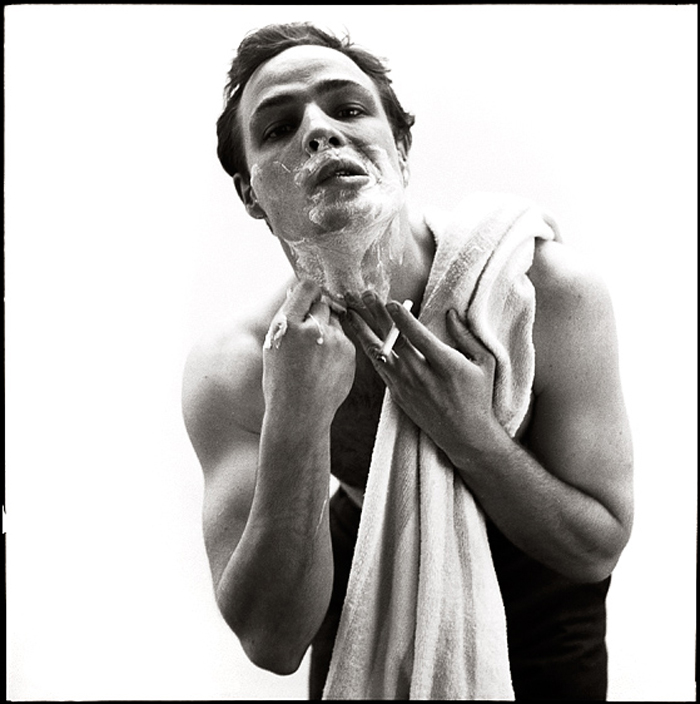Shaving is a ritual that millions of men perform every day. We do it to show the world a clean-shaven face that reflects our serious demeanor and dedication to a presentable appearance. Though some women prefer facial hair, in my experience a clean shave is the look that appeals most to women. If you have a moustache or beard, you should still take care to shave the rest of your face. Neck beards are not acceptable for serious men.
A real shave requires a sharp blade and that leaves open the possibility that you’ll cut yourself. Disposable razors have been modified over the years to minimize the risk of cutting yourself, and in so doing have sanitized and emasculated this manly art form. Disposable razors are intentionally expensive and do not give you a better shave than a high quality, double-sided razor.
Victor Pride wrote an excellent piece, “The 2 Minute Guide to Daily Shaving: How to Get Rid of Neck Bumps” that convinced me to ditch the disposable razors and to begin shaving daily and with a safety razor. His article is a great starting point for switching to a safety razor shave. Based on my experience I’ve learned some helpful tips that have improved my shaving experience.
Equipment
-I use the Merkur Model 180 Long Handled Safety Razor. The longer handle gives me more control when I shave, versus the traditional, short-handle models. Invest in a tool that will last a lifetime.
–Feather Razor Blades are made in Japan and regarded as the sharpest blades available. I see no reason to use a lesser blade. It’s great for a close shave and a 50-pack, which will last you a year, costs $20. How many disposable blades would last you a full week of daily shaves? A disposable razor cartridge will cost you $2-4. Assuming you use 2 per week, that’s $200-400 per year on cartridges alone. Get the Feathers.
-The Tweezerman Men’s Shaving Brush is a fine choice. There’s no need to spend $50-60 for a brush, but be sure to care for it properly. If you don’t buy a stand, improvise to hang your brush upside down to dry, to prevent bristle loss and handle cracking. The Amazon reviews have good tips for brush maintenance.
-I use Proraso Shaving Cream and Proraso Pre and Post Shave Cream. I use the Pre/Post Shave Cream on my neck, which is particularly sensitive, after I’ve wetted my face and before I apply shaving cream. I also use it after I’ve shaved.
Preparation
-Wet your brush with hot water and brush it across your face. You’ll need to wet it several times to cover your entire face, warming up your skin and preparing it for the shaving cream.
-If your skin is particularly sensitive, apply the pre shave cream. You don’t have to put it all over your face, just where your skin is most sensitive (upper neck, middle neck, etc.)
-A small amount of shaving cream (the size of your pinkie finger to the first knuckle) in a cup/mug will mix into a rich lather that will be plenty to cover your face. Use your brush to mix, but shake it out a bit if it is too wet, so that when you apply the shaving cream, water isn’t dripping down your face and diluting the cream. Apply the shaving cream with brush strokes, like a paintbrush, and also dab it on your neck and other sensitive areas to be sure the cream is worked in between your whiskers.
Shaving
-You can start anywhere, but I prefer to start with my neck, moving from left to right. Most cuts occur when trying to shave with a single motion. Until you have experience and get a feel for safety razor shaving, first lightly press the razor to your face, rotate it so it is at a 45 degree angle, then begin shaving downward (with the grain of your whiskers) using light to moderate pressure. Depending an the elasticity of your skin, it may suffice to angle your face upwards to stretch the skin on your neck, or you may need to use your free hand to pull down on the skin, under the area you are shaving. This creates a smoother surface on which the blade can travel.
-Rinse the blade in hot water after you’ve completed a full stroke with each side of the blade. Sometimes hair and cream will get stuck to the underside of the blade. It helps to loosen the blade handle while you rinse or you may need to use a thin object to dislodge the buildup.
-Shaving the same area with multiple strokes can cause irritation and lead to cuts. A method I use is a slight overlap of strokes for a better shave. I’ve noticed that the area of the blade directly in line with the handle gets a closer shave than the outside edges of the blade. If you’re shaving your neck, instead of moving directly from one plane to the next, after you’ve completed a vertical stroke, take your brush and lather the area 1/2 in. to the side of where you will shave next. On your next stroke shave along the new area and slightly overlap the area you just re-applied shaving cream to. If you happen to miss a patch anywhere on your face, reapply shaving cream before you shave it again. You may not need to do this for less sensitive areas, but you’ll learn through experience.
-Victor Pride recommends shaving against the grain at the area where your neck meets your chin to avoid razor irritation. I don’t have a problem with this area so I shave with the grain, but you’ll soon notice where your skin is most sensitive and adjust accordingly.
-When you first start shaving with a safety razor it is inevitable that you will cut yourself. As long as you are careful, these cuts will be easily treated with a hot shower and post-shave cream and if need be, a small piece of tissue paper pressed onto the cut and left to dry. As you are learning, you can try shorter strokes in between rinses, rather than one long stroke for the length of your neck. A great amount of pressure isn’t necessary, but it will take time to get a feel for how much you need. The best way to avoid the most annoying cuts is to never slide the razor horizontally across your face. This is especially apt to happen around the chin when moving your blade to your neck if you aren’t careful.
-Ideally you will want to shave every day. It gives you the cleanest look and it’s easier to shave one day’s growth, rather than two or more. When you are first starting though you will likely cut yourself and irritate your skin. It will help to skip a day or two in between shaves to allow your irritated skin to heal.
Post-Shave
-I use the remainder of the shaving cream in my brush to lather my face after I’ve shaved. This soothes the face for a minute before you hop into the shower.
-Rinse of your brush, using you thumb and forefinger to gently squeeze out the excess water. Give it one or two light shakes to get the rest of the water out. Hang your brush upside down to dry.
-Disassemble your razor and lay the blade and head pieces on a tissue or towel. Don’t wipe the blade, at most dab it with a tissue to remove any gunk, but a good final rinse in hot water should leave it clean.
-Take a moderately hot shower to open up the pores in your face and minimize razor bumps. Since doing the 30 Days of Discipline Program, I always finish my showers with a cold rinse.
-After your shower, dry your face and apply post-shave cream. If you have very sensitive skin, you may want to re-apply the cream later in the day. Washing your face once in the afternoon and evening with mild soap will also help soothe irritation.





